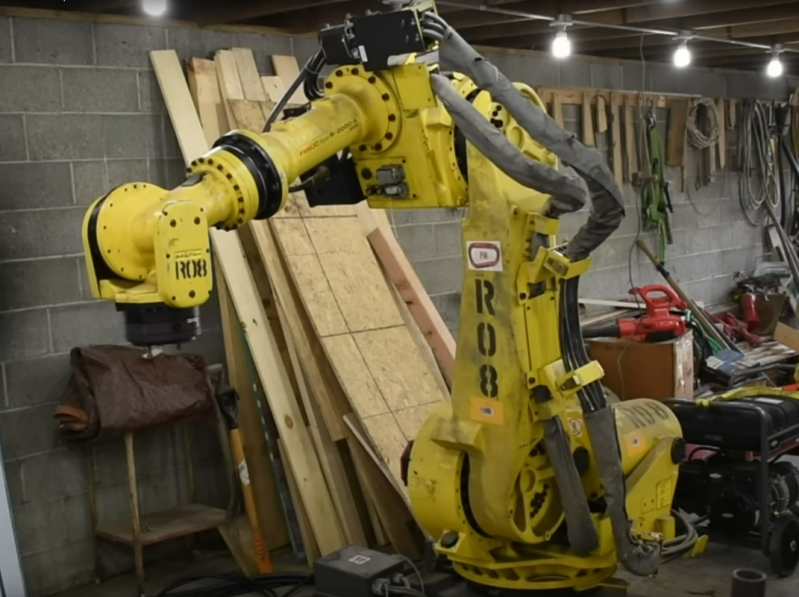Industrial robots are shockingly expensive when new, typically only affordable for those running factories of some sort. Once they’ve gone through their life cycle building widgets, they can be purchased for little more than scrap value, which is essentially free compared to their original sticker price. [Excessive Overkill] explains all of this in a video where he purchased one at this stage to try to revive, but it also shows us how to get some more life out of these robots if you can spend some time hunting for spare parts, installing open-source firmware, and also have the space for a robot that weighs well over a thousand kilograms.
This specific robot is a Fanuc R2000ia with six degrees of freedom and a reach of over two meters. Originally the plan was to patch together a system that could send modern gcode to the Fanuc controller, but this was eventually scrapped when [Excessive Overkill] realized the controller that shipped with this robot was for an entirely different machine and would never work. Attempts to find upgraded firmware were frustrated, and after a few other false starts a solution was found to get the robot working again using LinuxCNC and Mesa FPGA cards, which have built-in support for Fanuc devices like this.
More after the break…
After two years of trying various solutions to get the robot working properly, including suffering through the global chip shortage and trying to decode proprietary motor encoder information, [Excessive Overkill] has a fairly functional industrial-strength robot on his hands, albeit with a much slower speed than its original firmware supported. This isn’t much of a problem, though, since it’s not in an industrial setting anymore. There are some issues as well with the servo control and the PID settings, but this robot is still a work in progress. The hope is that eventually, the portable controller that was built for this robot would work on a large array of Fanuc robots. Building your own open-source controller has a number of benefits beyond getting old industrial robot arms back up and running too, like making sure to avoid a situation where an attacker has infiltrated and changed your robot.
















Awesome. A new heater, just in time for summer. Where I’m at, too many people are moving. We were already told that our independent power grid will not be able to cool us comfortably this summer. So we might as well use up all the available energy and mine bitcoin while we’re at it. /s
dam n I suck at replies. Ignore that…
https://hackaday.com/2023/05/13/home-heating-with-bitcoin-miners-is-now-a-real-thing/
Not ignoring it. lol
My secondary school scored an old industrial robot, probably free as a tax writeoff by the company that gave them it. So cool! We were so excited!
Then we realised it required 3-phase. Which was a bummer as the only room with skate for it didn’t have 3-phase. And then they realised that – whilst not as powerful as the one in this article – it could still fling a human’s weight around with a 6’ reach at high speeds, so it required a large safe area and cage. And even 20 years ago they realised that wasn’t safe to have around kids. So it just sat there. And eventually it was scrapped. I have one of the transformers from it as a doorstop.
Yeah industrial robots seem cool but unless you have a purpose for one they are just a pain. They are designed to be used with loads of safety measures in place and with their size and strength aren’t good for schools. For schools, smaller, desktop sized robots or even just simulations are a much better, safer and easier to use.
Even a desktop sized industrial robot usually has the speed and power to punch through your skull
Wow, looks very impressive. I admire the time you spent on this.
Building a servo controller is not that easy though. Maybe ping the odrive folks for some tips on the tuning and controller setup.
I did talk with the people from Odrive, looks like the low voltage, low update rate, and no friction compensation are probably the biggest issues. If there is enough interest in running industrial stuff there is the possibility they would release a high voltage Odrive, but that is a big step and lots of work.
Check out STMBL. It is a high voltage, open source servo drive. It had supply chain issues with some parts, but I think people are making them again.
STMBL can be configured to read Fanuc serial encoders for feedback and communicate with LinuxCNC via Mesa smart-serial for an all-digital control loop.
But the component supply issues are an issue.
https://github.com/rene-dev/stmbl/blob/master/docs/src/Getting%20Started.adoc
It’s also good to note FANUC doesn’t allow for transfer of software licensing between owners if a robot is resold, and don’t even think about calling them for support without being ready to pay a re-licensing fee.
(I’m a FANUC master-certified service engineer)
This practice may be illegal in EU – see Case C-128/11 – though i am not a lawyer so maybe FANUC has some loophole in this and can still deny transfer.
My Dad, worked at Raleigh Bicycles (Nottingham, UK) as a welder in the 1980s, where they installed some early PUMA robotic welders. These were based on the 16-bit LSI 11 architecture, a single-chip / multi-chip pdp-11 without extended instructions. You don’t need much to make a useful robot ;-) .
https://en.wikipedia.org/wiki/Programmable_Universal_Machine_for_Assembly
In my poor engineer days I worked at a Ford plant using fanuc robots and had a few head whacks by moving into the space belonging to them
They are very territorial!
B^)